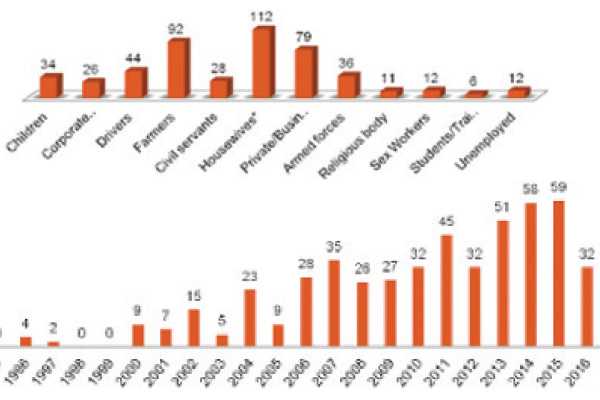HIV response structure and data flow
A vital document in the HIV response is the National Multisectoral HIV and AIDS Response Strategic Framework 2018 - 2023 which is currently on its third cycle - NSF III. The document serves to guide the national response and is reliant on international and regional frameworks such as the Sustainable Development Goals (SDGs) and the, “…2016 United Nations Political Declaration on HIV and AIDS which sets out the 2030 agenda” meaning that Botswana is intent on using a human-rights based approach, among others in its HIV response.
The document is also informed by other frameworks addressing different components of the HIV response such as the, “…global Strategy for Women’s, Children’s and Adolescents’ Health (2016-2030), the African Union agenda 2063 and the World Health Organisation’s technical guidance on treatment, care and support, elimination of mother to child transmission of HIV, voluntary medical male circumcision, and HIV pre-exposure prophylaxis among others.” At the core of the document which is close to a hundred pages long is the need to“enhance efficiencies through an integrated approach” in order to end AIDS as a public threat by the year 2030.
Dr. Boga Fidzani, a Demographer at the African Comprehensive HIV/AIDS Partnerships (ACHAP) who is also the Executive Officer for Programmes says the NSF III springboards off the SDG’s for setting targets at national level because, “this ensures synchronisation with global commitments associated with fighting the AIDS epidemic and associated socioeconomic challenges.” Fidzani further explains that the policy is a roadmap that keeps targets on track and in check. “The old saying ‘if you don’t know where you are going any road will take you there’ is still relevant,” he says. Outlined in the NSF III are key institutions identified to lead the local HIV response such as the National AIDS Coordinating Agency (NACA) which is tasked with among other activities ‘overseeing the coordination and management of the NSF III’ including the “financial resource mobilisation and allocation.”
The Ministry of Health and Wellness has responsibilities including ‘managing, implementing and strengthening the health sector HIV response’. The Ministry of Labour and Home Affairs has to ‘strengthen its leadership role in advocating for HIV and AIDS relevant policies and legislation addressing key sectors and populations (labour, women, immigration (non-citizens) and prisons’. Other government ministries are also allocated specific tasks but all have the overall role of developing workplace interventions and conducting relevant HIV research. Fidzani expands on the issue of non-citizens and advocates for their inclusion in the national HIV response and other relating HIV interventions and access to such HIV services.
He points out that Botswana is a “destination of choice for immigrants” from neighboring Zimbabwe as well as other countries and despite the arguments that “…laws do not permit free access to health services for this group that have been submitted and have won the day” it is in fact self-defeating from a public health perspective to exclude non-citizens as they might end up being the key drivers of the epidemic as long as they live among and interact with citizens.
Another critical aspect to the HIV response is data collection and ensuring that information collected reaches the appropriate institutions and informs the national response. The NSF III reads that, “Strategic information management comprises of the monitoring and evaluation (M&E) surveys and surveillance and HIV research.” This also means that the M&E of the HIV response in Botswana is dependent on the “three ones” principles. “The “one M&E framework” is linked to M&E systems in all sectors that report on HIV indicators – the public health information system, other government ministries, civil society and private sector M&E systems.”
In the early 2000’s Botswana designed a “multi-sectoral, multi-level national response” with a corresponding coordination and reporting structure. “All the sectors are represented at the National AIDS Council, where a national update on the national response is given on a regular basis. The report is based on a prioritised set of nationally agreed indicators, which are reviewed for relevance and accuracy from time to time,” says Fidzani.
Despite this, “recent consultations” have suggested that there is a need to strengthen M&E systems within Civil Society Organisations (CSOs) especially regarding their “…linkages to central government repositories,” says Fidzani. A current agenda is to sustain the HIV response by identifying sustainable interventions and strengthening and capacitating local and indigenous CSOs in order for them to fulfil mandates previously handled by mostly international organisations. CSOs also need to be capacitated so they do not compromise the standards that have been set in terms of service delivery. Another reason civil society is considered “a very important development partner” to Government is because the latter uses a centralised service delivery approach, where facilities are established within a community and then people go to the facility to seek the service.
This approach according to Fidzani is prone to accessibility challenges resulting from factors such as distance, and operating hours. “CSOs act to extend these services closer to the community, making them more accessible thus improving uptake and by extension, impact. “It is therefore important for them to have the right capacities so that quality of service is not compromised – hence government plays a key role in defining the operational standards and requisite capacity,” says Fidzani giving one example of the critical role of CSOs in the response to HIV. “Co-infection between HIV and TB has long been acknowledged and interventions put in place. Civil Society has played a significant role in tracing contacts of TB patients and making sure they are screened for TB.”
Fidzani explains that it is difficult, unscientific even, to compare pre-2008 data with data from the Botswana AIDS Impact Survey (BAIS) series. Before 2008 all statistics on HIV and AIDS were based on “Sentinel Surveillance results” which collected data from pregnant women aged 15 to 49 years.
“By nature this was a biased ‘sample’ of high risk people who by virtue of being pregnant had been exposed to infection and could therefore not be taken to represent the general population,” explains Fidzani. This resulted in estimates which were disproportionately high. Fidzani explains that the Botswana AIDS Impact Survey BAIS II of 2004 “corrected the data” because the sample was drawn systematically from across the general population and yielded an estimate of 17.1 percent. “This gave birth to a new generation of reliable statistics as the BAIS was repeated, with growing improvements in 2008 and 2013. Another one is on-going as we speak.” Despite the significantly differing methods in collection of data the HIV expert explains that it does not change the fact that Botswana faced, and continues to face, very high levels of HIV infection.
Reinforcing the need for accurate and coordinated data Fidzani explains that national targets would be near impossible to set without existing data as a guide. “We collect data to assess whether we are on track towards achieving set future targets. Based on what the data tells us, we are able to make decisions on whether to intensify our interventions, make some changes or even totally abandon them,” he says. The HIV expert notes some of the general trends from the data. Data shows that from around the age of 14 years HIV incidence is higher among females relative to males, a pattern which is maintained until the late thirties and early forties.
“For this reason, NSF III identifies adolescents and young people aged 10-24 as a priority population.” An added factor according to the NSF III is that “…young people aged 15-24 years account for a third of new HIV infections (34 percent) of which 69 percent occur among young women.” The framework goes on to pinpoint and target adolescent boys (10-19) and men specifically in a bid to address poor health seeking behaviours among this sub population. Recent estimates based on 2017/2018 data shows that the number of men who have sex with other men (MSM) is increasing in Botswana; from 2675 compared to about 700 in 2012. Fidzani partly attributes this to the changes in data collection methods. “Much of this difference could be however largely due to methodological differences between the two surveys,” notes Fidzani. Another factor could be that MSM are becoming more comfortable to “come out in a slowly but surely more accepting social and legal environment.”
This leads the demographer to the matter of HIV stigma and its impact on the national response which he says is hard to quantify. “Some people have even argued whether HIV-related stigma is still an issue in Botswana, that maybe self-stigmatisation is the problem. Generally Batswana have high awareness levels regarding HIV and AIDS and as a result attitudes towards those infected have been supportive. Treatment success has also contributed to the reduction of stigma over the years,” says Fidzani. Similarly the NSF III explains that, “There is insufficient data on the extent to which stigma hinders disclosure and HIV testing resulting to new infections nor the extent to which stigma contributes to AIDS related deaths through delayed initiation on ART.” The NSF III explains that the public health information system used by the Ministry of Health and Wellness comprises of, “…the Integrated Patient Management System (IPMS), Patient Information Management System (PIMS), District Health Information System (DHIS) and the open Medical Records System (MRS).”
Despite this there are“gaps and challenges” in availability of data at district level (DHIS), availability of community data at district and community level, availability of data at the national level data warehouse including “non-existence of HIV Research Agenda and inadequate capacity to carry out Research impacting negatively in projects planning and funding.” Other challenges noted in the NSF III are to do with the quality of the data collected such as the use of a “paper-based system” which is said to compromise the data due to its lack of “completeness, accuracy and timeliness.” Another gap is the weak M&E system at times perpetuated by donor funding or lack thereof.
“Most M&E positions are donor supported and the M&E staff tend to leave their posts when programmes close. M&E audits and routine data quality assessments are not conducted regularly,” states the policy document. To strategically manage this information the NSF speaks to strategies that have been put in place to strengthen, develop, implement, capacitate, allocate, disseminate, recruit, conduct, collaborate and integrate in attempts to circumvent the identified gaps and challenges.
Fidzani agrees that Botswana based on the NSF is in gear to attain the international targets of ending AIDS in the community by the year 2020 at 90-90-90and 2030 at 95-95-95 but he also preaches the basics. “Prevention is always far better than cure, it could avert massive costs related with treatment. However it hinges strongly on behaviour change regarding sexual practices, and this has proved a difficult undertaking,” he says.





